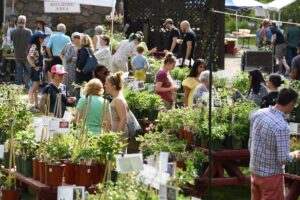For the gardener, February typically means spending time indoors, perusing the many catalogs that you probably receive and planning for the coming season.
Just looking at pages of colorful plants can make spring seem not so far away.
However, February is also the perfect time to go out into your garden for some tree trimming and landscape maintenance. Even a garden composed mostly of perennials and flowering shrubs can be visually exciting throughout the coldest months. The trick is to re-define “interest” during a time of year when your garden can’t rely on showy blooms, vibrant colors and lush foliage. Beauty in the winter garden is more spare and sculptural, utilizing form, shape and texture to catch the eye. This is achieved by incorporating plants whose features shine when all else has gone dormant for the season.
Trees and shrubs with distinctive bark are great assets in the garden during the winter. Red- and Yellow-twig dogwoods (Cornus alba or sericea) are deciduous shrubs (those that lose their leaves in the cold weather) with bright red or yellow branches. A cluster of these shrubs set against a snowy backdrop is striking. Oakleaf hydrangea (Hydrangea quercifolia) is my favorite hydrangea, as it offers interest almost year-round. It is a handsome shrub, with rugged, oak-shaped leaves, large white blooms and beautiful fall foliage. In addition, as the shrub matures, it develops an exfoliating bark that offers great textural appeal. Paper birch (Betula papyrifera) and Paperbark maple (Acer griseum) are 2 examples of trees that also exhibit peeling bark.
Ornamental grasses are invaluable in the garden, particularly in winter. They provide structure and scale much like shrubs, but also contribute sound and movement, enhancing the sensory experience of being in your garden. In winter, when other plants have died back or shed their leaves, perennial grasses remain full and upright, often fading to muted shades of buff and tan – they are especially beautiful after a snowfall. Grasses range in height from 6” to over 6’ so they can be successfully integrated in the garden from front to back. Two favorite grasses are Maiden grass (Miscanthus sinensis) and Fountain grass (Pennisetum alopecuroides).
The seedheads of many perennials can be left up over the winter, contributing shape and texture. Some examples include Black-eyed Susan (Rudbeckia fulgida), Astilbe, Purple coneflower (Echinacea purpurea) and Sedum “Autumn Joy.” Many of these plants offer the additional bonus of providing a food source for birds during these lean months.
So go outside and take a look at your garden, as well as others in your neighborhood. Bundle up and visit public gardens such as the New York Botanical Garden or Wave Hill, where the more quiet and subdued aesthetic of the winter landscape is executed with the same attention to detail as the rest of the year. Take pictures, make notes, and this spring add some “winter” plants to your garden.
Enjoy your garden!
Sheri Silver owns fiori garden design in Irvington – she can be reached at sherifiori@aol.com






